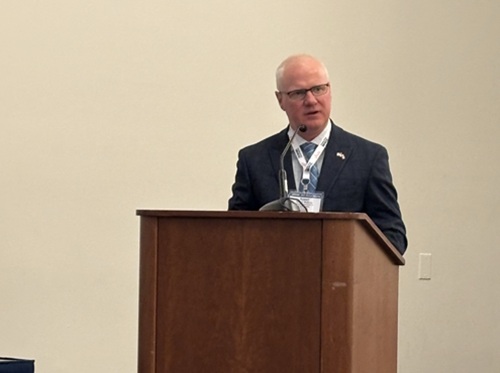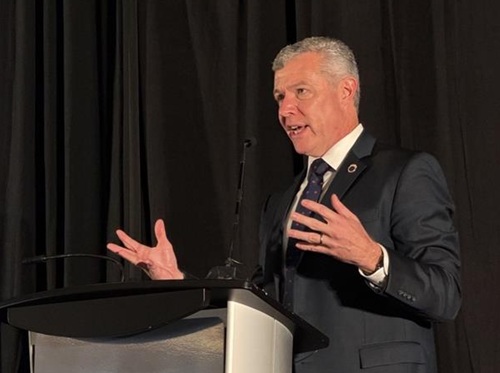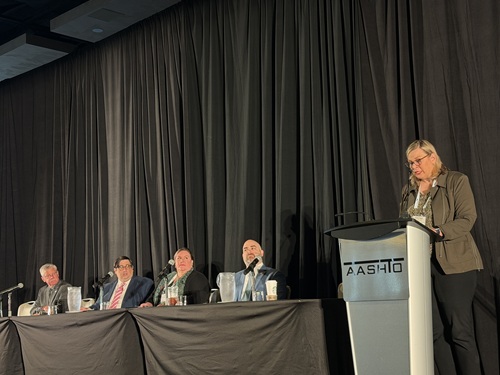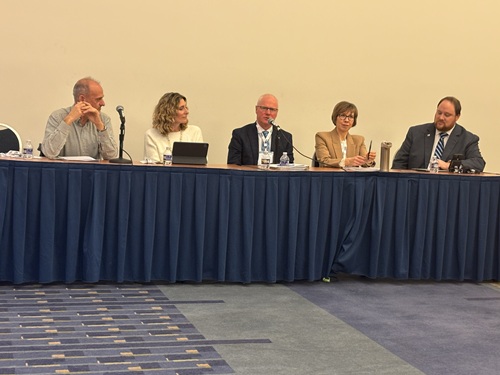A session at the 2025 Transportation Research Board’s Annual Meeting in Washington, D.C., brought together a group of federal and state government leaders, as well as mobility industry executives, to discuss the potential opportunities of Intelligent Transportation Systems or ITS.
[Above photo by AASHTO]
Moderated by HTNB’s Matthew Junak, senior project manager, that panel discussion – entitled “State of Intelligent Transportation Systems: Strategic Directions and Industry Priorities” – featured Russell McMurry, commissioner of the Georgia Department of Transportation; Valerie Briggs, acting associate administrator for the Office of Innovation and Workforce Solutions at the Federal Highway Administration; Laura Chace, president and CEO of the Intelligent Transportation Society of America; and Angelos Amditis, research director of the Institute of Communication and Computer Systems or ICCS, who serves as chair of ERTICO – ITS Europe, a public-private and cross-border intelligent transportation initiative.

Georgia DOT’s McMurry – who also serves as vice president of the American Association of State Highway and Transportation Officials – stressed that “deployment is a journey” when it comes to ITS technologies.
“Technology moves faster than us and we must be ready and willing to adapt,” he explained, stressing that transportation leaders need to outline their strategic ITS priorities and initiatives, so such technologies help improve safety, mobility, and the traveler experience.
“When there is a hurricane in Florida, everyone comes to Georgia,” McMurry noted. “[That’s why] we will have [outfitted] or [set up] all of our interstates with broadband so that we can put more roadside units out there.”
FHWA’s Briggs stressed that “interoperability is key” when adopting new technology; highlighting the need to clearly define milestones for both ITS and Vehicle-to-Everything or V2X systems.
V2X – a communication system that allows vehicles to exchange information with one another, infrastructure, pedestrians, and networks – will play a crucial role in improving safety, traffic management, and driving efficiency, she emphasized.

[Editor’s note: In August 2024 the U.S. Department of Transportation unveiled the finalized version of its V2X national deployment plan. That 19-page plan – officially entitled “Saving Lives with Connectivity: A Plan to Accelerate V2X Deployment” and initially released in draft form for public comment in October 2023 – is focused on improving road safety, mobility, and efficiency through the broader use of V2X technology.]
That is why securing the necessary financial support for advancements like V2X technology will require a combination of funding sources, Briggs stressed. “It will rely on all different levels of funding to get our infrastructure out there,” she said. “V2X is no different.”
ITS America’s Chace emphasized the importance of “walking the walk” when it comes to investing in technology, as it can “help us save lives while taking a proactive approach to safety,” she said.
“We can do better. We have the tools, we have the leadership, and we do have the funding,” she said. “It is up to all of us … we have to be the ones who foster change.”
That becomes even more critical because the Infrastructure Investment and Jobs Act or IIJA of 2021 – the current five-year surface transportation reauthorization funding package – invests only one tenth of one percent in technology programs, according to Chace.
Aside from funding, Chace highlighted the need to bolster the workforce and ensure the right people are in place to implement these new technologies. “It is important to support our workforce as next technology evolves,” she said. “We need to go beyond technology adoption to true technology integration.”
Leveraging the international perspective, ICCS’s Angelos noted that “for Europe, ITS aligns directly with sustainability.” He highlighted the collaboration between the United States and the European Union, showcasing how both regions can close the gap between public and private partnerships and work together to tackle the next technological challenges.
“There is a new elephant in the room – artificial intelligence [AI],” Angelos pointed out. “Europe is proud to create the first law related to AI, which is [one of] the first advance AI but also safeguard our society and our citizens from the possible side effects that may come out from that.”
From bolstering the workforce to implementing new technologies, the TRB session panelists underscored that broader education and support are essential for widespread adoption of ITS technologies in the transportation industry.
“We need to grow beyond the champions of this new technology,” said FHWA’s Briggs. “As the industry moves forward, engaging a wider audience will be key to successfully integrating these ITS, V2X, and other emerging technologies into everyday life.”
 Top Stories
Top Stories
Collaboration Touted at AASHTO’s Third Safety Summit
October 31, 2025 Top Stories
Top Stories

